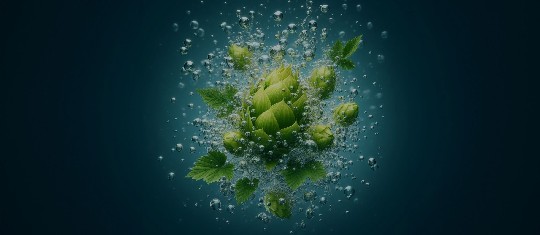CBD cola, bubble tea, kombucha, chia lemonade and “healthy” functional energy drinks – interest in non-alcoholic beverages is growing and new creations are flooding the market. The “NoLo” (no and low alcohol) and “mindful drinking” consumer trends are fueling sales of non-alcoholic beers, wines, and spirits, and mocktails.
Craft brewers are getting in on the act, too. Following in the slipstream of the popular juicy and hazy IPAs, a beverage has emerged that is both simply and ingeniously refreshing: Hop water! It contains neither alcohol nor sweeteners. That’s because it’s simply water with hops. Depending on the hop variety, it smells of sweet fruits, berries, or citrus; it’s sparkling, with a slightly bitter taste, a hint of acidity, and a mild finish; and it’s distinctly more-ish.
It’s no surprise, then, that hop water has established itself on the craft beer scene as a non-alcoholic alternative with a brewing connection. The first of its kind is attributed to American homebrewer Paul Tecker who launched “H2OPS” in 2014. Browar Nepomucen is believed to have been the first European brewery to market a hop water with its launch of “Nachmielona Woda” some years ago. In the USA, Lagunitas was the first major brewery to do so with their “Hoppy Refresher”, followed by Sierra Nevada with “Hop Splash” and many others. In Europe, Northern Monk from Leeds, Sudden Death from Timmendorfer Strand and Vagabund from Berlin are gearing up, too.
Hop water is easy to produce, as it has only three ingredients: Water, hops, and acid. Getting the flavor balance right is a bit fiddly, though. For a real kick, hop water can be seasoned with other natural ingredients. BarthHaas took a closer look at the subject and presented a new beverage at the BrauBeviale trade show in 2023 that met with a very favorable response. To enhance the health benefits of this sugar- and calorie-free beverage, they added B vitamins and rounded it off with lemon verbena, lemon balm, and kumquat for natural aroma.
The experts at BarthHaas recommend citric acid (instead of lactic acid) to reduce the pH value a little, thus adding freshness and balancing out the bitter flavor of the hops. The key question, however, is how to get the hops into the water. The product developers see three possibilities: First, dry hopping produces highly complex hop notes with little bitterness – like the flavor profile of dry-hopped juicy and hazy beers that appeals to IPA fans in particular. The risk here is that if dosage is too high, the humulones will produce a rough bitterness. Second, hot extraction at 65 to 75 degrees Celsius produces a bitterness that – if dosed correctly – is well integrated and has a soft mouthfeel. The hop aroma is incorporated well here, too. All in all, this method produces the most flavor, but requires the greatest skill. Highly aromatic hop varieties such as Citra®, Mosaic®, Galaxy® or Eclipse® in the form of pellets like LUPOMAX® are best suited for both processes. Filtration is recommended after using pellets.
Third, hop water can be produced on the basis of hop oils like the PHAs® (Pure Hop Aroma) from BarthHaas. They are added shortly before bottling and provide an initially fresh aroma, but take a back seat when the water is being drunk and leave no bitterness behind. As a result, this kind of hop water appeals to consumers who are unfamiliar with dry-hopped beers and simply enjoy a delightfully flavored water. All that’s left to be done is carbonate the hop water and bottle it.
Hop water is an exciting new daytime drink and a welcome change from pure water, providing hydration and, as a bonus, offering a moment of “grown-up” (not sweet, slightly bitter!) refreshment and indulgence. And speaking of indulgence, hop water is an ideal ingredient for cocktails. Which brings us full circle: Let the night life begin – because hop water is a round-the-clock beverage!


